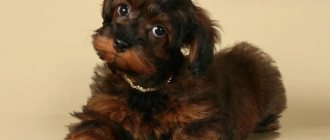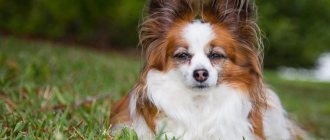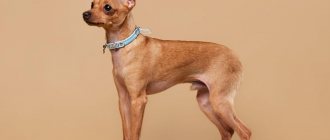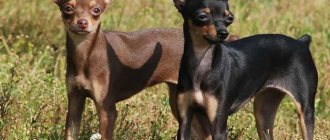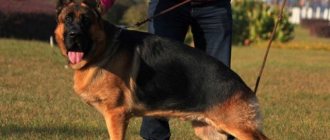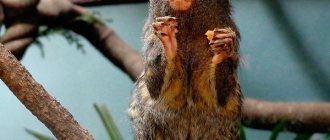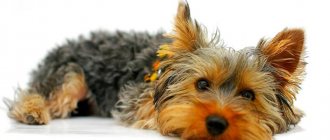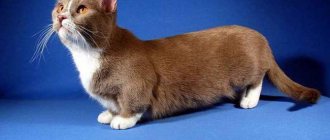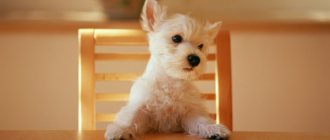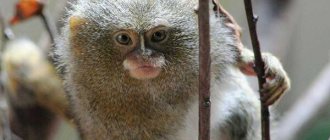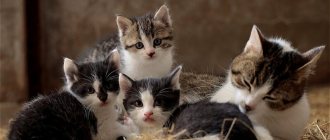Brief historical background
The creator and author of this unique breed is a fairly well-known Russian breeder and dog handler N.P. Nasibova . She began developing a new breed line relatively recently; the idea of getting a small, cute lap dog, best suited for apartment conditions, was born in 1993, and in 1997 the first animals appeared. Several miniature dog breeds were used in the selection work, the list of which the author does not disclose in order to avoid fakes. Over several years of painstaking work, we managed to breed a small pet with the desired breed characteristics.
At the end of 2007, the breed under the official and original name “Petersburg Orchid” was included in the register of State protected breeding achievements in the section of domestic dogs . A patent and copyright certificate were issued. Currently, Nina Nasibova is the head and leader of the special-breed dog club “Petersburg Orchid”, she solely controls the breeding of the breed (exercises author’s control), all documents for the livestock are issued by her personally, certified by signature and seal.
The St. Petersburg Orchid breed was developed by breeder Nina Nasibova
The breed is not yet considered completely established; it is constantly being improved and improved. Selection work on the creation of new mixed-blood lines continues tirelessly, otherwise the breed will not be able to breed within itself without an influx of someone else's fresh blood from the outside. None of the international cynological associations currently recognize St. Petersburg orchids; these dogs are known exclusively on the territory of our country.
Since our beloved city was preparing to celebrate its 300th anniversary, I wanted my many years of work to become a kind of gift to our city. I love my city, I was born in St. Petersburg. And I called it an orchid because it is a very exquisite flower with a rich range of colors. It seems to me that our dogs live up to their name: the St. Petersburg orchid also has a very large palette of colors, and they themselves look very elegant and impressive, and often even exotic.
From an interview with N. Nasibova
Video: conversation about the St. Petersburg orchid with the author of the breed
Character
The St. Petersburg Orchid has a cheerful, cheerful character; these dogs are cute, playful and loving. They behave very actively on the street; at home they are usually more balanced and calm. As a rule, they get along well with other pets. There is absolutely no aggression or cowardice in the character of the St. Petersburg Orchid. Dogs often show interest and friendliness even towards strangers. Many are very vigilant, catching the slightest rustle outside the door and reporting it to the owner in a clear voice. They treat children very well, love to play with them, but it is better to protect the fragile orchid from the “care” of very small children.
Description of the St. Petersburg Orchid breed
The Petersburg (or Neva) orchid has the status of a companion dog . Such pets are kept only as decorative pets and exclusively “for the soul.”
The Petersburg Orchid is a purely decorative indoor breed of dog.
Appearance
The physique of orchids is compact and harmonious, the format is slightly elongated with dry, developed muscles and medium-sized bones of medium strength . The body is slightly elongated, the chest is oval, the chest is widened and straight with pronounced withers, the stomach is tucked.
Breed standards:
- Weight - 2–4 kg.
- Height at withers - 17–30 cm.
- The head is small, rectangular in outline, dry and light, on a high, long and curved neck.
- The skull is rounded, the length of the somewhat wide muzzle is at least a third of the entire head. The stop is well defined and noticeable, but not sharp. The nose is not very large, painted black or to match the main color.
- The jaws are not too powerful and well developed with small white teeth in a scissor bite.
- The eyes are oval-shaped, small in size, set wide and far apart. Iris of dark shades.
- Rounded, medium-sized ears are set high, hang on cartilage, and are covered with elongated hair.
- The tail is set quite low (below the level of the back), and bends upward in the form of a saber or a ring. It can be stopped in the area of 3–4 vertebrae.
- The limbs are straight and high (the length of the legs is equal to half the height at the withers), located parallel. The oval paws are small, collected in a dense ball.
The St. Petersburg orchid should not exceed 30 cm in height
The coat is moderately thick and long, made of fairly hard guard hair, without undercoat (in some individuals that often walk outside, it can grow back). The coat is usually straight, but a slight wave is also allowed. The standard allows any colors, excluding white (only single white spots on the face, paws and chest are allowed):
- plain - black, red (from pale sand to red), silver, lilac, chocolate, etc.;
- brindle - from gray to red;
- black and tan - with tan in gray, yellow, red, smoky and other shades;
- multi-colored - a combination of several contrasting colors.
The standard allows for a variety of colors of the Neva orchid
The Neva orchid moves in a balanced manner, quickly and easily, freely extending its limbs and pushing off strongly.
We have developed a specific “orchid” haircut. The hair on the body and neck is removed like the haircut of an American Cocker Spaniel. Hair remains on the head on the bangs, beard, mustache and ears. On the front legs, hair is removed up to the carpal joints, on the hind legs - up to 1/5 of the hock joints. The fur on the hind and front legs is neatly evened out.
Website of the special breed club "Petersburg Orchid"
A special haircut has been invented for orchids
Character and psyche
A distinctive feature of the Neva orchid is its wonderful, light and flexible character . The animals are extremely friendly and devoid of any aggression towards anyone. Miniature pets never give preference to one most beloved owner; they treat all members of the family equally equally, not forgetting at the same time to faithfully love acquaintances, friends, neighbors, relatives and in general everyone indiscriminately. There is enough positive and kind emotional charge for everyone.
The dog is very cheerful and active, loves to move and play. He gets along well with children of all ages, allowing himself to be squeezed and tossed, but never gets angry or bites. She easily finds a common language with other pets and is always happy to meet new people. She perceives strangers as her best friends, immediately offering to play with her. Possessing a balanced psyche, he sits calmly and for a long time in his master’s arms while shopping or visiting.
Orchid dogs are active and inquisitive
He learns the rules of behavior in the house without any problems, quickly understands his place and perfectly masters the territory, using the necessary places for their intended purpose. It is recommended that such dogs be owned by people who have enough free time to spend time with their pet. Otherwise, he will feel lonely and abandoned.
The gullibility of small decorative dogs is partly a disadvantage. A good friend of mine had her beloved dog stolen in this way, who was left to sit on a sofa in a furniture store while the owner went away somewhere for a while. The friendly animal immediately goes into everyone’s arms, not suspecting any tricks.
Disadvantages and disqualifying vices
Since the breeding of Neva orchids is completely under the control of the author and the head of the club, she rejects all individuals that do not meet the standard requirements herself. There are no specific instructions at this point in the standard.
Choosing a puppy
You can buy a purebred St. Petersburg Orchid puppy only at N. Nasibova’s club, since fakes come across very often . It is almost impossible even for a specialist to visually distinguish a small purebred animal from a mongrel animal with external similarity. All differences usually appear only with age (bad character, too large size, etc.).
You need to buy a puppy with all the necessary documents
Each club puppy is branded (at the groin), and a puppy card is also issued for him. Parents are carefully selected for mating, so there are no unplanned offspring. Upon purchase, a sales contract is issued, which indicates the purchase price and breeding value of the animal. Documents for each dog and all information relating to it are duplicated and stored in the club. The handwritten signature of the author of the breed (N. Nasibova) and the club’s seal are a guarantee of the quality of the purchased puppy.
The only club that is engaged in pedigree breeding is my club - the St. Petersburg Specialty Dog Breeding Club "Petersburg Orchid". I am the head of the club and, as the author of the breed, the main dog handler responsible for breeding work. There are many breeders in the club. Many of them are professional breeders. To facilitate breeding work and breeding, each breeder has his own attachment. For example, “Sosnovy Bor Souvenir” - by Olga Toporova, “Ocean of Fantasy” - by Olya Demidova, by Sveta Anisimova - “Chocolate Paradise”, by Irina Orlova - “Creation of Love”.
From an interview with N. Nasibova
Price of puppies
Prices for St. Petersburg orchids are determined by their breeding status (for breeding or just for fun), size, age, color and other parameters. Bitches are usually sold for no less than 50 thousand rubles, males can already be purchased for 30 thousand rubles. Individuals with some shortcomings are given away much cheaper (from 15 thousand rubles). The cost of exclusive individuals can reach up to 2 thousand dollars.
Neva Orchid puppies are not cheap
Origin story
In 1997, in St. Petersburg, Nina Nasibova had the idea of bringing a completely new breed of dogs. She wanted to create a variety of decorative dogs that would become popular even outside the country. I wanted the pets to be small in size, which would allow me to take them with me on any trip or journey. Another distinctive feature should have been friendliness and playfulness.
To achieve this goal, representatives of the following breeds were used:
- Russian colored lapdog;
- chihuahua;
- Yorkshire Terriers;
- toy poodles.
The work was very complex and lasted for 3 years. Many attempts were made, most of which were unsuccessful, and only a few yielded positive results. As a result, several specimens were selected for subsequent selection, during which they tried to improve the breed.
Orchid care
In order for the dog to always be pleasing to the eye and remain attractive, its fur must be carefully looked after . One of the main advantages of this miniature breed is the absence of seasonal shedding and the characteristic dog smell. Dead hairs do not fall out on their own; they are removed by combing. Bath procedures are carried out once every 7–10 days, using special shampoos, balms and conditioners (LASER LITES, Iv San Bernard, HOUSE OF AN-JU, etc.). If it is not possible to wash the dog, then dry sprays are used. After washing, the coat is thoroughly dried with a hairdryer and combed with a comb.
Regular haircuts are carried out every two months. Ears are cleaned weekly, eyes are wiped every day, and teeth are always brushed with a special brush and toothpaste that does not require rinsing (once a week). The claws are shortened as they grow (about once every 1–1.5 months).
Like many miniature breeds, in orchids, with improper nutrition and poor care, the anal glands often become inflamed. Therefore, they are cleaned at least once a quarter by squeezing the secretion out of the bags. To do this, you need to carefully and gently press on both sides of the anus, and then rinse it with a weak solution of potassium permanganate.
Neva orchids were bred artificially to feed on ready-made freeze-dried food; their digestive system is best suited for this food. The food must be of high quality, not lower than super premium (Meradog, Pronature, Orijen, etc.). Portions must be strictly dosed and fed twice a day (adult dogs). Puppies are fed more often - from 2 to 6 times, depending on their age.
Natural food for small dogs is very difficult to make complete and balanced, so it’s better not to risk it.
St. Petersburg orchids need to be fed with special food for small breeds of dogs.
It is highly not recommended to pamper your pet even with treats from the common table. Although some owners feed their animals with specially prepared homemade food at their own risk.
Neva orchids do not need daily walking; they can stay at home all the time . They can be easily trained to do their toilet chores in a cat litter box, on a newspaper or a rag. Aviary keeping for such mini-dogs is completely unsuitable; they cannot be kept in cages (like some breeders). A tame pet should always be close to people. When walking in the cold season, it is recommended to wear warm clothes (vests, overalls, etc.) on the orchid.
When it's cold outside, the dogs are dressed in warm clothes.
Video: cutting the Neva orchid
Training
There is no need for any special training for lap dogs, but the pet must be taught good behavior from childhood . Even the most fragile creature can become a real pet monster if you let it do whatever it wants. The animal must clearly understand the boundaries of what is permitted and comply with the established rules. A smart orchid quickly remembers the simplest commands and learns very easily.
The puppy needs to be immediately explained what can and cannot be done.
Education and training
The St. Petersburg Orchid is a smart and quick-witted dog. She is easy to train.
For these miniature dogs, the most important part of training is toilet training. This process begins when the puppy is kept with its mother. Already from the age of three weeks, as soon as the offspring takes their first steps from their mother, they begin to learn to go to the toilet on a napkin. When a little orchid gets to a new home with a new owner, everything is unusual and scary for her.
Puppies begin to be toilet trained at three weeks of age.
Toilet training algorithm:
- Until the puppy has adapted, movement around the apartment should be limited to one room without carpet.
- Next to the bed you need to put food and water and a familiar napkin nearby, which the breeder should give you when buying a dog: a familiar smell will quickly help the puppy decide on the correct behavior.
- When the dog goes to the napkin, it must be praised and rewarded with a small piece of treat (cheese, boiled chicken or beef tripe). If the very first time the puppy did not go to the intended place, just move the napkin there.
- If your pet makes puddles in the wrong place, you need to punish him, but under no circumstances hit him. For a dog, punishment is when they take it by the withers and poke its nose into a puddle. After this action, under no circumstances should you place your pet on a toilet napkin. The dog will perceive this as a ban on using this item.
- After a period of adaptation and obtaining the desired result, every day, little by little, move the toilet napkin to the place where you planned, or place it in the tray.
This type of training is one of the simplest and works well even for inexperienced dog breeders.
If you wish, you can teach your pet commands: sit, come to me, fu, voice. But, usually, miniature dogs are not taught this.
Orchid diseases
According to the breeders, no genetic diseases inherent in the St. Petersburg orchid have been detected. All defective and sick individuals are not allowed for breeding. But the breed is quite young, and there is not yet enough statistical data to draw conclusions about its typical diseases.
There are problems with the anal glands, but this is typical for all miniature breeds. At the same time, the dog behaves restlessly, licks the anus area and rubs this area against horizontal surfaces. Advanced purulent inflammatory processes can lead to sepsis and death. You will need to contact your veterinarian immediately.
The lifespan of orchid dogs is usually around 12–14 years.
